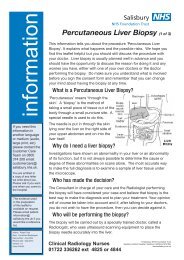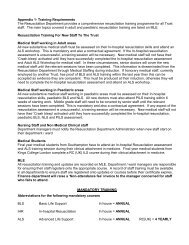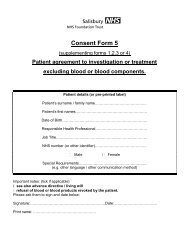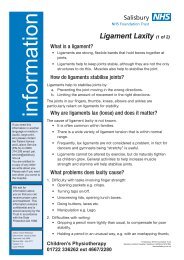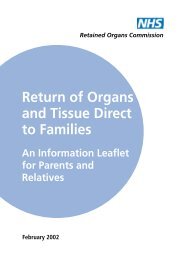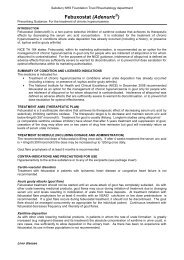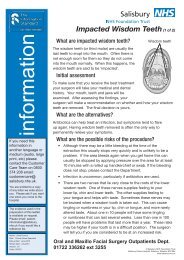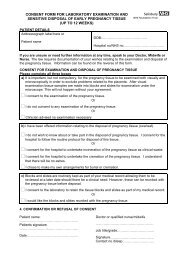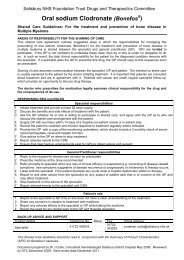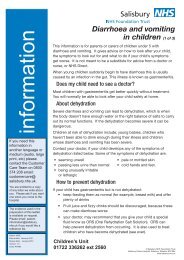Skin Grafts - ICID - Salisbury NHS Foundation Trust
Skin Grafts - ICID - Salisbury NHS Foundation Trust
Skin Grafts - ICID - Salisbury NHS Foundation Trust
You also want an ePaper? Increase the reach of your titles
YUMPU automatically turns print PDFs into web optimized ePapers that Google loves.
Full thickness skin graft (FTSG)<br />
This is most commonly used to replace skin on the hand or face.<br />
The skin is made up of a number of layers. For FTSG, all the layers are used, down to the fat<br />
layer. It is usually taken from:<br />
• behind or in front of the ear<br />
• above the collar bone (clavicle)<br />
• upper inner arm<br />
• groin<br />
The area that it is taken from depends on several things, for example<br />
• colour of skin<br />
• amount of skin required<br />
• previous surgery<br />
• the area needing new skin<br />
There are other areas which can be used which your surgeon will discuss this with you.<br />
The FTSG is then placed on to the area that needs new skin. It is usually kept in place by a<br />
bright yellow dressing. Stitches are used to keep everything from slipping. The ends of the<br />
stitches are kept long and then ‘tied over’ the yellow dressing. This dressing MUST not be<br />
touched for five to seven days.<br />
The donor area is stitched together. A little dressing will be put over the area. Keep the wound<br />
and dressing clean. If this dressing falls off, don’t worry.<br />
Special instructions<br />
After any operation there is always some swelling in the affected part of your body. To help<br />
prevent this, try to rest the affected part during the day in the following way:<br />
• head – sit upright<br />
• arm – hold your hand higher than your heart<br />
• leg - keep it higher than your hip.<br />
At night sleep with your:<br />
• head on an extra pillow<br />
• arm above your heart, i.e. nearer the ceiling<br />
• leg higher than your hip.<br />
<strong>Skin</strong> <strong>Grafts</strong> (2 of 8)<br />
If you don’t do this, you may experience more pain than you should, swelling may be increased<br />
and healing might take longer.<br />
Pain<br />
For many people the donor area is more uncomfortable than the graft area.<br />
• If you experience discomfort or pain from either the donor or graft area, painkillers can be<br />
taken.<br />
• Take the pain killers as instructed. However you should contact Plastic Outpatients or your<br />
GP for advice if you feel that pain has become a problem.<br />
• Most people find taking painkillers regularly, before the pain or discomfort becomes too<br />
bad, keeps it under control.<br />
01722 336262<br />
Laverstock Ward - ext 4312/3<br />
Plastic Dressing Clinic - ext 2352<br />
© <strong>Salisbury</strong> <strong>NHS</strong> <strong>Foundation</strong> <strong>Trust</strong><br />
<strong>Salisbury</strong> District Hospital, <strong>Salisbury</strong>, Wiltshire SP2 8BJ<br />
www.salisbury.nhs.uk



